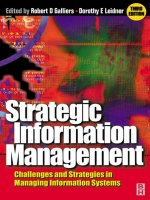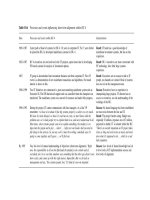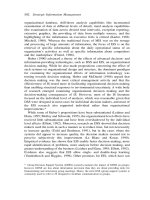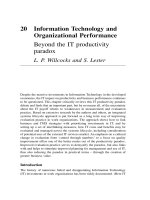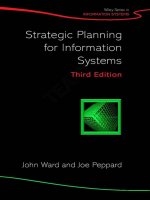Managing information systems 7th edition brow ch010
Bạn đang xem bản rút gọn của tài liệu. Xem và tải ngay bản đầy đủ của tài liệu tại đây (528.95 KB, 32 trang )
MANAGEMENT INFORMATION SYSTEMS
CHAPTER 10
METHODOLOGIES FOR PURCHASED SOFTWARE PACKAGES
Copyright © 2011 Pearson Education, Inc. publishing as Prentice Hall
10-1
THE MAKE-OR-BUY DECISION
.
- In large companies today, application software is typically both custom developed and purchased.
-
In small businesses, software is typically purchased.
Why?
Copyright © 2011 Pearson Education, Inc. publishing as Prentice Hall
10-2
THE MAKE-OR-BUY DECISION
Advantages and Disadvantages of Purchasing
Copyright © 2011 Pearson Education, Inc. publishing as Prentice Hall
10-3
PURCHASING METHODOLOGY
Initiating the Purchasing process
•
Development of a high-level cost estimate - with business manager and IS analyst input
Copyright © 2011 Pearson Education, Inc. publishing as Prentice Hall
10-4
PURCHASING METHODOLOGY
The Purchasing Steps
•
Steps for purchasing application packages fit into the three SDLC phases (referred to as the modified SDLC approach)
Fig 10.1
Copyright © 2011 Pearson Education, Inc. publishing as Prentice Hall
10-5
PURCHASING METHODOLOGY
The Purchasing Steps, continued
•
In comparison to an SDLC methodology, the Definition phase has additional steps, and the Construction
phase is greatly reduced.
•
In special circumstances, if the package is new, the purchaser may play a major role as an Alpha or Beta site
for the vendor:
- Alpha site: plays a role in determining the final functionality and user interface design for the new
package
- Beta site: plays a role in user acceptance testing
α
β
Copyright © 2011 Pearson Education, Inc. publishing as Prentice Hall
10-6
PURCHASING METHODOLOGY
Definition Phase
•
Two traditional SDLC steps:
•
Five additional steps:
Copyright © 2011 Pearson Education, Inc. publishing as Prentice Hall
10-7
DEFINITION PHASE
Feasibility Analysis
•
Determine whether the proposed system is economically, technically, and operationally feasible
•
In addition, the feasibility of purchasing rather than building the system is considered
- Preliminary investigation of available packaged systems
- Detailed cost-benefit analysis for budgeting and monitoring purposes
Copyright © 2011 Pearson Education, Inc. publishing as Prentice Hall
10-8
DEFINITION PHASE
Requirements Definition
•
As when creating custom software, Requirements Definition is a critical step in the purchase methodology
•
But rather than create detailed requirements for in-house custom development, this step focuses on defining
functional requirements needed to develop a Request for Proposal (RFP)
Copyright © 2011 Pearson Education, Inc. publishing as Prentice Hall
10-9
DEFINITION PHASE
Create Short List of Suitable Packages
•
Eliminate all but a few promising candidate packages
•
Evaluate:
- Available features of a package
- Compatibility with current hardware and software
- Vendor track record
Copyright © 2011 Pearson Education, Inc. publishing as Prentice Hall
10-10
DEFINITION PHASE
Establish Criteria for Selection
•
•
Business and IS team members work together to determine relevant criteria to select the best package
Some criteria may be mandatory, while others may be desirable
Copyright © 2011 Pearson Education, Inc. publishing as Prentice Hall
10-11
DEFINITION PHASE
Develop and Distribute RFP
•
Request for Proposal (RFP): A formal document sent to potential vendors inviting them to submit a
proposal describing their software package and how it meets the company’s needs
•
Gives vendors information about:
- System’s objectives and requirements
- Environment in which the system will be used
- General criteria used to evaluate proposals
- Conditions for submitting proposals
Copyright © 2011 Pearson Education, Inc. publishing as Prentice Hall
10-12
DEFINITION PHASE
Example of Content in RFP
Copyright © 2011 Pearson Education, Inc. publishing as Prentice Hall
10-13
DEFINITION PHASE
Choose Package
•
Collect data from:
- Vendors’ responses from RFPs
- Vendor demonstrations (for a few leading packages)
•
References from users in other companies
Project team evaluates how well available packages meet company’s needs
Copyright © 2011 Pearson Education, Inc. publishing as Prentice Hall
10-14
DEFINITION PHASE
Negotiate Contract
•
Use of an attorney for contracting with a vendor reduces likelihood of future legal problems
•
Contract type has implications for the risk level of the purchasing company
- for fixed-price contracts, the purchasing company knows the total price in advance
- for cost-reimbursement contracts, the purchasing company pays the vendor’s direct and indirect costs
and thus assumes a much greater risk
Copyright © 2011 Pearson Education, Inc. publishing as Prentice Hall
10-15
PURCHASING METHODOLOGY
Discrepancies between needs and package capabilities will need to be dealt with by:
- Modifying the package
- Changing internal procedures
- Living with the differences
Copyright © 2011 Pearson Education, Inc. publishing as Prentice Hall
10-16
CONSTRUCTION PHASE
•
•
System Design and Building steps are only necessary if modifications are to be made to the package.
However, essentially all packages will require “configuring” the package to meet the organization’s needs
by making choices using pre-programmed templates by the vendor.
Copyright © 2011 Pearson Education, Inc. publishing as Prentice Hall
10-17
CONSTRUCTION PHASE
•
System Design and Building:
- Typically the vendor does not provide the source code for the package, so the company typically
contracts with the vendor (or a certified third party firm) for modifying the package.
•
Changes may also be required for other existing company systems that interface with the package.
System Testing:
- User acceptance testing of configured package (and/or modified package)
-
IS specialist or vendor testing on organization’s equipment
Copyright © 2011 Pearson Education, Inc. publishing as Prentice Hall
10-18
IMPLEMENTATION PHASE
•
Same three steps as for Implementation phase for custom development:
Copyright © 2011 Pearson Education, Inc. publishing as Prentice Hall
10-19
IMPLEMENTATION PHASE
Installation
•
•
Installation planning, training, data cleanup, and conversion
Success dependent on:
- Quality of vendor support
-
Package size and complexity
•
Special attention needs to be given to training, especially if there are significant changes in the way
employees do their work
•
Change management is a set of activities designed to help overcome resistance by business users to the new
system
Copyright © 2011 Pearson Education, Inc. publishing as Prentice Hall
10-20
IMPLEMENTATION PHASE
Operations
•
•
•
Operations is the same, whether the package was built or bought
Initial success highly dependent on good communication with the vendor
Long-term success also dependent on how well the system has been integrated into the company’s ongoing
operations
Copyright © 2011 Pearson Education, Inc. publishing as Prentice Hall
10-21
IMPLEMENTATION PHASE
Maintenance
•
•
Most common = vendor handles package maintenance, as specified in the contract
Advantage:
•
Can lead to significant cost avoidance over the life of the system
Disadvantages:
- Purchasing company totally dependent on vendor for future system changes
- May not get specific changes that the company wants
Copyright © 2011 Pearson Education, Inc. publishing as Prentice Hall
10-22
PURCHASING METHODOLOGY
Project Team
•
•
•
•
•
•
Project manager: usually is an IS manager, but may be a business manager (or both)
IS analysts and IS specialists who will operate the system
Representatives of key business managers and users
Software vendor personnel
Sometimes a third-party implementation partner (other than vendor)
For contracting:
purchasing specialists and attorneys
Copyright © 2011 Pearson Education, Inc. publishing as Prentice Hall
10-23
ENTERPRISE SYSTEM PACKAGES
•
Enterprise Resource Planning (ERP) systems are software packages designed to integrate all departmental
and functional systems into a single integrated system
•
Packages are more complex to implement because they can impact an entire enterprise
•
Companies purchase to achieve business benefits and IT platform benefits, such as:
- Enables access to integrated data for better decision making
- Takes advantage of client/server platform
Copyright © 2011 Pearson Education, Inc. publishing as Prentice Hall
10-24
ENTERPRISE SYSTEM PACKAGES
.
Source: Brown and Vessey, MIS Quarterly Executive, 2003
Copyright © 2011 Pearson Education, Inc. publishing as Prentice Hall
10-25

